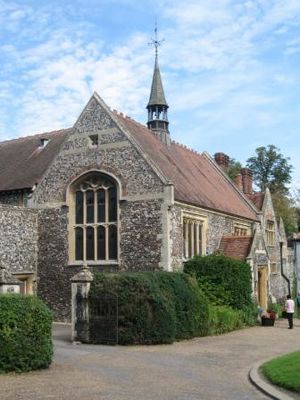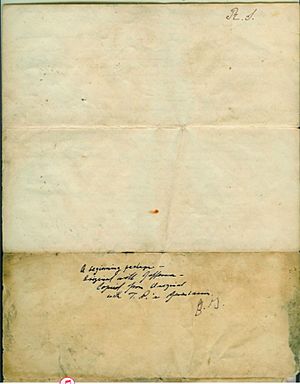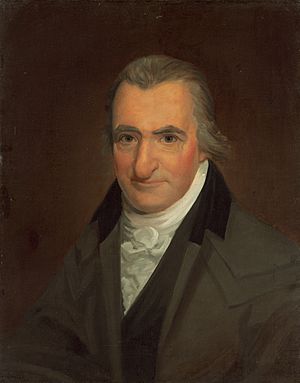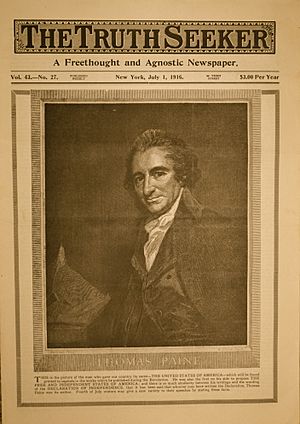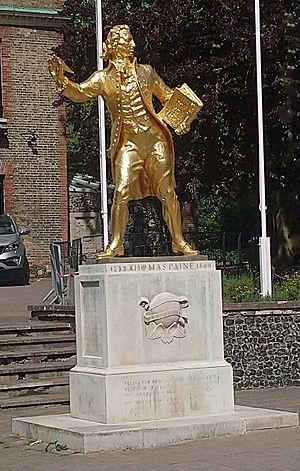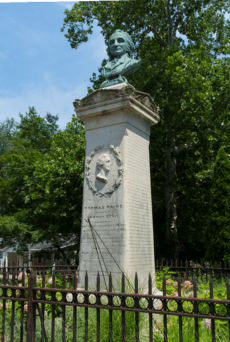Thomas Paine facts for kids
Quick facts for kids
Thomas Paine
|
|
|---|---|

Portrait by Laurent Dabos, c. 1792
|
|
| Born |
Thomas Pain
February 9, 1737 (N.S.) |
| Died | June 8, 1809 (aged 72) |
| Spouse(s) |
|
| Era | Age of Enlightenment |
| School | |
|
Main interests
|
|
| Signature | |
Thomas Paine (born Thomas Pain; February 9, 1737 [O.S. January 29, 1736] – June 8, 1809) was an English-born American political activist, philosopher, political theorist, and revolutionary. He authored Common Sense (1776) and The American Crisis (1776–1783), two of the most influential pamphlets at the start of the American Revolution, and helped inspire the Patriots in 1776 to declare independence from Great Britain, theretofore an unpopular cause. His ideas reflected Enlightenment-era ideals of transnational human rights.
Contents
Early life and education
Thomas Paine was born on January 29, 1736 (NS February 9, 1737), the son of Joseph Pain, a tenant farmer and stay-maker, and Frances (née Cocke) Pain, in Thetford, Norfolk, England. Joseph was a Quaker and Frances an Anglican. Despite claims that Thomas changed the spelling of his family name upon his emigration to America in 1774, he was using "Paine" in 1769, while still in Lewes, Sussex.
He attended Thetford Grammar School (1744–1749), at a time when there was no compulsory education. At the age of 13, he was apprenticed to his father. Following his apprenticeship, aged 19, Paine enlisted and briefly served as a privateer, before returning to Britain in 1759. There, he became a master staymaker, establishing a shop in Sandwich, Kent.
On September 27, 1759, Paine married Mary Lambert. His business collapsed soon after. Mary became pregnant; and, after they moved to Margate, she went into early labour, in which she and their child died.
In July 1761, Paine returned to Thetford to work as a supernumerary officer. In December 1762, he became an Excise Officer in Grantham, Lincolnshire; in August 1764, he was transferred to Alford, also in Lincolnshire, at a salary of £50 per annum. On August 27, 1765, he was dismissed as an Excise Officer for "claiming to have inspected goods he did not inspect". On July 31, 1766, he requested his reinstatement from the Board of Excise, which they granted the next day, upon vacancy. While awaiting that, he worked as a staymaker.
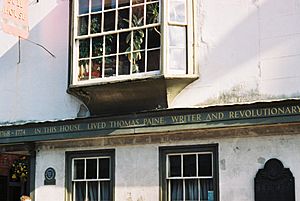
In 1767, he was appointed to a position in Grampound, Cornwall. Later he asked to leave this post to await a vacancy, and he became a schoolteacher in London.
On February 19, 1768, he was appointed to Lewes in Sussex, a town with a tradition of opposition to the monarchy and pro-republican sentiments since the revolutionary decades of the 17th century. Here he lived above the 15th-century Bull House, the tobacco shop of Samuel Ollive and Esther Ollive.
Personal life
On March 26, 1771, at age 34, Paine married Elizabeth Ollive, the daughter of his recently deceased landlord, whose business as a grocer and tobacconist he then entered into. He formally separated from his wife Elizabeth on June 4, 1774, and moved to London.
American Revolution
In September 1774, mathematician, Fellow of the Royal Society, and Commissioner of the Excise George Lewis Scott introduced Paine to Benjamin Franklin, who was there as a voice for colonial opposition to British colonial rule. He was also publisher and editor of the largest American newspaper, The Pennsylvania Gazette. Franklin suggested emigration to Philadelphia. He handed out a letter of recommendation to Paine, who emigrated in October to the American colonies, arriving in Philadelphia on November 30, 1774.
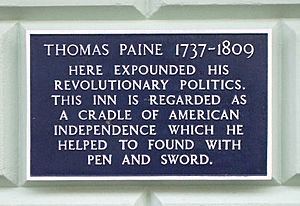
Paine barely survived the transatlantic voyage. The ship's water supplies were bad and typhoid fever killed five passengers. On arriving at Philadelphia, he was too sick to disembark. Benjamin Franklin's physician, there to welcome Paine to America, had him carried off ship; Paine took six weeks to recover. He became a citizen of Pennsylvania "by taking the oath of allegiance at a very early period". In March 1775, he became editor of the Pennsylvania Magazine, a position he conducted with considerable ability.
Paine arrived just in time to participate in the American Revolution. Virtually every rebel read (or listened to a reading of) his 47-page pamphlet Common Sense, proportionally the all-time best-selling American title, which catalysed the rebellious demand for independence from Great Britain. The American Crisis was a pro-revolutionary pamphlet series.
Possible involvement in drafting the Declaration of Independence

While there is no historical record of Paine's involvement in drafting the Declaration of Independence, some scholars of Early American History have suspected Thomas Paine's involvement over the past two centuries.
In 2018, the Thomas Paine National Historical Association introduced an early draft of the Declaration that contained evidence of Paine's involvement based on an inscription of "T.P." on the back of the document. John Adams made a hastily written manuscript copy of the original draft of the Declaration of Independence on June 24, 1776, known as the Sherman Copy. Adams made this copy shortly before preparing another neater, fair copy that is held in the Adams Family Papers collection at the Massachusetts Historical Society. The Sherman copy of the Declaration of Independence is one of several working drafts of the Declaration, made for Roger Sherman's review and approval before the Committee of Five submitted a finalized draft to Congress. The Sherman Copy of the Declaration of Independence contains an inscription on the back of the document that states: "A beginning perhaps-Original with Jefferson-Copied from Original with T.P.'s permission." According to the Thomas Paine National Historical Association, the individual referenced as "T.P." in the inscription appears to be Thomas Paine.
The degree to which Paine was involved in formulating the text of the Declaration is unclear, as the original draft referenced in the Sherman Copy inscription is presumed lost or destroyed. However, John Adams' request for permission of "T.P." to copy the original draft may suggest that Paine had a role either assisting Jefferson with organizing ideas within the Declaration, or contributing to the text of the original draft itself.
French Revolution
Paine lived in France for most of the 1790s, becoming deeply involved in the French Revolution. While in England, he wrote Rights of Man (1791), in part a defense of the French Revolution against its critics. His attacks on Anglo-Irish conservative writer Edmund Burke led to a trial and conviction in absentia in England in 1792 for the crime of seditious libel.
The British government of William Pitt the Younger, worried by the possibility that the French Revolution might spread to Britain, had begun suppressing works that espoused radical philosophies. Paine's work, which advocated the right of the people to overthrow their government, was duly targeted, with a writ for his arrest issued in early 1792. Paine fled to France in September 1792.
Paine was an enthusiastic supporter of the French Revolution, and was granted honorary French citizenship alongside prominent contemporaries such as Alexander Hamilton, George Washington, Benjamin Franklin and others. Paine's honorary citizenship was in recognition of the publishing of his Rights of Man, Part II and the sensation it created within France. Despite his inability to speak French, he was elected to the National Convention, representing the district of Pas-de-Calais.
In December 1793, he was arrested and was taken to Luxembourg Prison in Paris. While in prison, he continued to work on The Age of Reason (1793–1794). James Monroe, a future President of the United States, used his diplomatic connections to get Paine released in November 1794.
Paine became notorious because of his pamphlets and attacks on his former allies, who he felt had betrayed him. In The Age of Reason and other writings he advocated Deism, promoted reason and freethought, and argued against institutionalized religions in general and the Christian doctrine in particular. In 1796, he published a bitter open letter to George Washington, whom he denounced as an incompetent general and a hypocrite. Upset that U.S. President George Washington, a friend since the Revolutionary War, did nothing during Paine's imprisonment in France, Paine believed Washington had betrayed him and conspired with Robespierre.
He published the pamphlet Agrarian Justice (1797), discussing the origins of property and introduced the concept of a guaranteed minimum income through a one-time inheritance tax on landowners.
Later years
In 1802 or 1803, Paine left France for the United States. He also paid the passage for the family of his French friend Nicolaus Bonneville: Bonneville's wife Marguerite Brazier and the couple's three sons, Benjamin, Louis and Thomas Bonneville, to whom Paine was godfather.
Paine was not welcomed by his former friends and partisans because of his attacks on religion and George Washington. His right to vote was denied in New Rochelle on the grounds that Gouverneur Morris did not recognize him as an American and Washington had not aided him.
Marguerite Brazier took care of Paine at the end of his life and buried him after his death. In his will, Paine left the bulk of his estate to Marguerite, including 100 acres (40.5 ha) of his farm so she could maintain and educate Benjamin and his brother Thomas. In 1814, the fall of Napoleon finally allowed Bonneville to rejoin his wife in the United States where he remained for four years before returning to Paris to open a bookshop.
Death
On the morning of June 8, 1809, Paine died, aged 72, at 59 Grove Street in Greenwich Village, New York City. Although the original building no longer exists, the present building has a plaque noting that Paine died at this location.
After his death, Paine's body was brought to New Rochelle, but the Quakers would not allow it to be buried in their graveyard as per his last will, so his remains were buried under a walnut tree on his farm. Only six people attended his funeral, as he had been ostracized for his ridicule of Christianity and attacks on the nation's leaders.
In 1819, English journalist William Cobbett dug up his bones and transported them back to England with the intention to give Paine a heroic reburial on his native soil, but this never came to pass. The bones were still among Cobbett's effects when he died over fifteen years later, but were later lost. There is no confirmed story about what happened to them after that, although various people have claimed throughout the years to own parts of Paine's remains, such as his skull and right hand.
Ideas
Slavery
Paine was an strong critic of slavery, declaring himself an abolitionist. As secretary to the Pennsylvania legislature, he helped draft legislation to outlaw trade in slaves.
Paine, together with Joel Barlow, unsuccessfully tried to convince President Thomas Jefferson to not import the institution of slavery to the territory acquired in the Louisiana Purchase, suggesting he rather settle it with free Black families and German immigrants.
State funded social programs
In his Rights of Man, Part Second, Paine advocated a comprehensive program of state support for the population to ensure the welfare of society, including state subsidy for poor people, state-financed universal public education, and state-sponsored prenatal care and postnatal care, including state subsidies to families at childbirth. Recognizing that a person's "labor ought to be over" before old age, Paine also called for a state pension to all workers starting at age 50, which would be doubled at age 60.
Agrarian Justice
His last pamphlet, Agrarian Justice, published in the winter of 1795, opposed agrarian law and agrarian monopoly and further developed his ideas in the Rights of Man about how land ownership separated the majority of people from their rightful, natural inheritance and means of independent survival. The U.S. Social Security Administration recognizes Agrarian Justice as the first American proposal for an old-age pension and basic income or citizen's dividend. Per Agrarian Justice:
In advocating the case of the persons thus dispossessed, it is a right, and not a charity ... [Government must] create a national fund, out of which there shall be paid to every person, when arrived at the age of twenty-one years, the sum of fifteen pounds sterling, as a compensation in part, for the loss of his or her natural inheritance, by the introduction of the system of landed property. And also, the sum of ten pounds per annum, during life, to every person now living, of the age of fifty years, and to all others as they shall arrive at that age.
In 2011, £10 and £15 would be worth about £800 and £1,200 ($1,200 and $2,000) when adjusted for inflation.
Lamb argues that Paine's analysis of property rights marks a distinct contribution to political theory. His theory of property defends a libertarian concern with private ownership that shows an egalitarian commitment. Paine's new justification of property sets him apart from previous theorists such as Hugo Grotius, Samuel von Pufendorf and John Locke. Lamb says it demonstrates Paine's commitment to foundational liberal values of individual freedom and moral equality. In response to Paine's "Agrarian Justice", Thomas Spence wrote "The Rights of Infants" wherein Spence argues that Paine's plan was not beneficial to impoverished people because landlords would just keep raising land prices, further enriching themselves rather than giving the commonwealth an equal chance.
Religious views
Before his arrest and imprisonment in France, knowing that he would probably be arrested and executed, following in the tradition of early 18th-century British Deism Paine wrote the first part of The Age of Reason (1793–1794). Paine's religious views as expressed in The Age of Reason caused quite a stir in religious society, effectively splitting the religious groups into two major factions: those who wanted church disestablishment, and the Christians who wanted Christianity to continue having a strong social influence.
About his own religious beliefs, Paine wrote in The Age of Reason:
I believe in one God, and no more; and I hope for happiness beyond this life.
I do not believe in the creed professed by the Jewish church, by the Roman church, by the Greek church, by the Turkish church, by the Protestant church, nor by any church that I know of. My own mind is my own church. All national institutions of churches, whether Jewish, Christian or Turkish, appear to me no other than human inventions, set up to terrify and enslave mankind, and monopolize power and profit.
Whenever we read the obscene stories, the voluptuous debaucheries, the cruel and tortuous executions, the unrelenting vindictiveness with which more than half the Bible is filled, it would be more consistent that we call it the word of a demon than the word of God. It is a history of wickedness that has served to corrupt and brutalize mankind; and, for my part, I sincerely detest it, as I detest everything that is cruel.
Though there is no evidence Paine himself was a Freemason, upon his return to America from France he penned "An Essay on the Origin of Free-Masonry" (1803–1805) about Freemasonry being derived from the religion of the ancient Druids. Marguerite de Bonneville published the essay in 1810 after Paine's death, but she chose to omit certain passages from it that were critical of Christianity, most of which were restored in an 1818 printing. In the essay, Paine stated that "the Christian religion is a parody on the worship of the Sun, in which they put a man whom they call Christ, in the place of the Sun, and pay him the same adoration which was originally paid to the Sun." Paine also had a negative attitude toward Judaism. While never describing himself as a Deist, he openly advocated Deism in his writings, and called Deism "the only true religion":
The opinions I have advanced ... are the effect of the most clear and long-established conviction that the Bible and the Testament are impositions upon the world, that the fall of man, the account of Jesus Christ being the Son of God, and of his dying to appease the wrath of God, and of salvation, by that strange means, are all fabulous inventions, dishonorable to the wisdom and power of the Almighty; that the only true religion is Deism, by which I then meant, and mean now, the belief of one God, and an imitation of his moral character, or the practice of what are called moral virtues – and that it was upon this only (so far as religion is concerned) that I rested all my hopes of happiness hereafter. So say I now – and so help me God.
Legacy
Historian Jack P. Greene stated:
In a fundamental sense, we are today all Paine's children. It was not the British defeat at Yorktown, but Paine and the new American conception of political society he did so much to popularize in Europe that turned the world upside down.
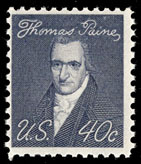
Harvey J. Kaye wrote that through Paine, through his pamphlets and catchphrases such as "The sun never shined on a cause of greater worth," "We have it in our power to begin the world over again," and "These are the times that try men's souls" did more than move Americans to declare their independence:
[H]e also imbued the nation they were founding with democratic impulse and aspiration and exceptional – indeed, world-historic – purpose and promise. For 230 years Americans have drawn ideas, inspiration, and encouragement from Paine and his work.
John Stevenson argues that in the early 1790s, numerous radical political societies were formed throughout England and Wales in which Paine's writings provided "a boost to the self-confidence of those seeking to participate in politics for the first time." In its immediate effects, Gary Kates argues, "Paine's vision unified Philadelphia merchants, British artisans, French peasants, Dutch reformers, and radical intellectuals from Boston to Berlin in one great movement."
His writings in the long term inspired philosophic and working-class radicals in Britain and United States. Liberals, libertarians, left-libertarians, feminists, democratic socialists, social democrats, anarchists, free thinkers and progressives often claim him as an intellectual ancestor. Paine's critique of institutionalized religion and advocacy of rational thinking influenced many British freethinkers in the 19th and 20th centuries, such as William Cobbett, George Holyoake, Charles Bradlaugh, Christopher Hitchens and Bertrand Russell.
The quote "Lead, follow, or get out of the way" is widely but incorrectly attributed to Paine. It can be found nowhere in his published works.
Abraham Lincoln
In 1835, when he was 26 years old, Abraham Lincoln wrote a defense of Paine's deism. A political associate, Samuel Hill, burned the manuscript to save Lincoln's political career. Historian Roy Basler, the editor of Lincoln's papers, said Paine had a strong influence on Lincoln's style:
No other writer of the eighteenth century, with the exception of Jefferson, parallels more closely the temper or gist of Lincoln's later thought. In style, Paine above all others affords the variety of eloquence which, chastened and adapted to Lincoln's own mood, is revealed in Lincoln's formal writings.
Thomas Edison
The inventor Thomas Edison said:
I have always regarded Paine as one of the greatest of all Americans. Never have we had a sounder intelligence in this republic.... It was my good fortune to encounter Thomas Paine's works in my boyhood... it was, indeed, a revelation to me to read that great thinker's views on political and theological subjects. Paine educated me, then, about many matters of which I had never before thought. I remember, very vividly, the flash of enlightenment that shone from Paine's writings, and I recall thinking, at that time, 'What a pity these works are not today the schoolbooks for all children!' My interest in Paine was not satisfied by my first reading of his works. I went back to them time and again, just as I have done since my boyhood days.
South America
In 1811, Venezuelan translator Manuel Garcia de Sena published a book in Philadelphia that consisted mostly of Spanish translations of several of Paine's most important works. The book also included translations of the Declaration of Independence, the Articles of Confederation, the U.S. Constitution and the constitutions of five U.S. states.
It subsequently circulated widely in South America and through it Uruguayan national hero José Gervasio Artigas became familiar with and embraced Paine's ideas. In turn, many of Artigas's writings drew directly from Paine's, including the Instructions of 1813, which Uruguayans consider to be one of their country's most important constitutional documents, and was one of the earliest writings to articulate a principled basis for an identity independent of Buenos Aires.
Memorials
The first and longest-standing memorial to Paine is the carved and inscribed 12-foot marble column in New Rochelle, New York, organized and funded by publisher, educator and reformer Gilbert Vale (1791–1866) and raised in 1839 by the American sculptor and architect John Frazee, the Thomas Paine Monument (see image below).
New Rochelle is also the original site of Thomas Paine's Cottage, which along with a 320-acre (130 ha) farm were presented to Paine in 1784 by act of the New York State Legislature for his services in the American Revolution. The same site is the home of the Thomas Paine Memorial Museum.
In the 20th century, Joseph Lewis, longtime president of the Freethinkers of America and an ardent Paine admirer, was instrumental in having larger-than-life-sized statues of Paine erected in each of the three countries with which the revolutionary writer was associated. The first, created by Mount Rushmore sculptor Gutzon Borglum, was erected in the Parc Montsouris, Paris, just before World War II began but not formally dedicated until 1948. It depicts Paine standing before the French National Convention to plead for the life of King Louis XVI. The second, sculpted in 1950 by Georg J. Lober, was erected near Paine's one-time home in Morristown, New Jersey. It shows a seated Paine using a drum-head as a makeshift table. The third, sculpted by Sir Charles Wheeler, President of the Royal Academy, was erected in 1964 in Paine's birthplace, Thetford, England. With a quill pen in his right hand and an inverted copy of The Rights of Man in his left, it occupies a prominent spot on King Street. Thomas Paine was ranked No. 34 in the 100 Greatest Britons 2002 extensive Nationwide poll conducted by the BBC.
In popular culture
- The 1982 French-Italian film That Night in Varennes is about a fictional meeting of Casanova, Chevalier de Seingalt (played by Italian actor Marcello Mastroianni), Nicolas Edmé Restif de la Bretonne, Countess Sophie de la Borde and Thomas Paine (played by American actor Harvey Keitel) as they ride in a carriage a few hours behind the carriage carrying the King and Queen of France, Louis XVI and Marie Antoinette, on their attempt to escape from revolutionary France in 1791.
- Jack Shepherd's 1989 stage play In Lambeth dramatized a visit by Thomas Paine to the Lambeth home of William and Catherine Blake in 1789.
- In 1987, Richard Thomas appeared on stage in Philadelphia and Washington, DC, in the one-man play "Citizen Tom Paine," playing Paine "like a star-spangled tiger, ferocious about freedom and ready to savage anyone who stands in his way," in a staging of Howard Fast's play in the bicentennial year of the United States Constitution.
- In 1995, the English folk singer Graham Moore released a song called Tom Paine's Bones on an album of the same name. The song has since been covered by a number of other artists, including Dick Gaughan, Grace Petrie and Trials of Cato.
- In 2005, Trevor Griffiths published These are the Times: A Life of Thomas Paine, originally written as a screenplay for Richard Attenborough Productions. Although the film was not made, the play was broadcast as a two-part drama on BBC Radio 4 in 2008, with a repeat in 2012. In 2009, Griffiths adapted the screenplay for a production entitled A New World at Shakespeare's Globe theatre on London's South Bank.
- In 2009, Paine's life was dramatized in the play Thomas Paine Citizen of the World, produced for the "Tom Paine 200 Celebrations" festival
- Paine is referenced in "The Schuyler Sisters", a song from the 2015 musical Hamilton.
See also
 In Spanish: Thomas Paine para niños
In Spanish: Thomas Paine para niños
- Asset-based egalitarianism
- British philosophy
- Contributions to liberal theory
- Liberty
- List of American philosophers
- List of British philosophers
- List of civil rights leaders
- Society of the Friends of Truth
- Early American publishers and printers


